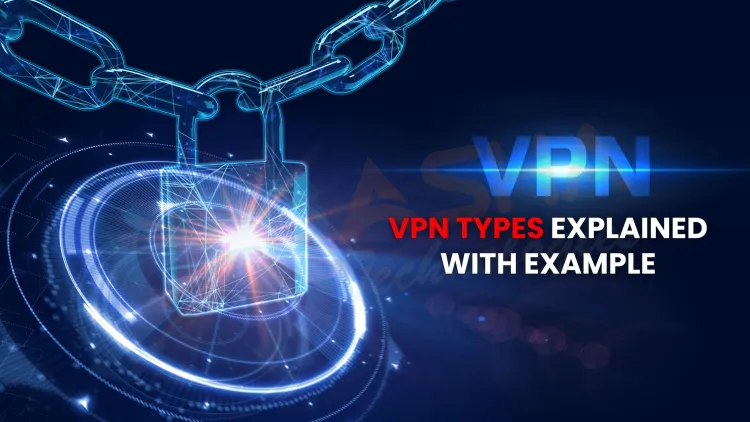Types of VPN | IPSec, L2TP, PPTP, and SSL VPN Explained with Real Examples
Discover the different types of VPN protocols including IPSec, L2TP/IPSec, PPTP, and SSL VPN. Learn how each VPN works, real-time use cases, security comparisons, and which VPN is best for your needs.

Table of Contents
- Quick Comparison
- IPSec VPN
- L2TP/IPSec VPN
- PPTP VPN
- SSL VPN (TLS‑based)
- Choosing the Right VPN Type
- Hardening Tips for Any VPN Deployment
- Conclusion
- Frequently Asked Questions (FAQs)
Virtual Private Networks (VPNs) create encrypted tunnels between users and resources, protecting data in transit and masking IP addresses. While “VPN” is often used generically, several protocol families achieve this goal in different ways. This guide breaks down four of the most common VPN types — IPSec, L2TP/IPSec, PPTP, and SSL VPN — highlighting how each one works, where it excels, and when you should (or should not) deploy it.
Quick Comparison
| Feature | IPSec VPN | L2TP/IPSec VPN | PPTP VPN | SSL VPN (AnyConnect / TLS) |
|---|---|---|---|---|
| Transport Layer | IP protocol suite (ESP/AH) | L2TP for tunneling + IPSec for crypto | GRE + PPP | TLS/DTLS over HTTPS |
| Encryption Strength | AES‑128/256 (modern) | AES‑128/256 (inherits IPSec) | MPPE‑128 (weak by modern standards) | AES‑128/256 (TLS 1.2/1.3) |
| Typical Use Case | Site‑to‑site and remote access for enterprises | Legacy VPN concentrators, some mobile carriers | Legacy compatibility, low‑risk data | Remote workforce, SaaS access, BYOD |
| NAT Traversal Support | Yes (NAT‑T, UDP 4500) | Yes (UDP 1701 + 4500) | Limited | Native through HTTPS port 443 |
| Platform Support | Built‑in on most OSes, routers, firewalls | Native on Windows, macOS, Linux, mobile | Legacy Windows, some routers | Browser‑based or client‑based, cross‑platform |
| Security Posture | Strong if configured correctly | Strong but adds overhead | Weak, easily cracked | Strong, relies on modern TLS versions |
| Speed / Overhead | Moderate | Higher (double encapsulation) | High speed, low overhead | Moderate, can leverage hardware offload |
1. IPSec VPN
How it works
IPSec operates at the network layer, encrypting and authenticating IP packets with protocols called ESP (Encapsulating Security Payload) and AH (Authentication Header). Two main modes are available: transport mode (encrypting just the payload) and tunnel mode (encrypting the entire packet). Negotiation happens through IKE v1 or IKE v2.
Strengths
-
Enterprise‑grade encryption (AES‑128/256)
-
Widely supported by routers, firewalls, and operating systems
-
Ideal for site‑to‑site links and remote access with strict compliance needs
Weaknesses
-
Complex to configure (policies, phase 1/2, algorithms)
-
May struggle with aggressive NAT if NAT‑T is disabled
-
Requires client software or native OS support for mobile users
Real‑world example
A multinational company links branch offices to headquarters using IPSec tunnel mode between Cisco ASA firewalls, ensuring ERP data remains encrypted across the public internet.
2. L2TP/IPSec VPN
How it works
Layer 2 Tunneling Protocol (L2TP) creates a point‑to‑point tunnel; IPSec then provides encryption and authentication. Essentially, traffic gets encapsulated twice: first by L2TP, then by IPSec ESP.
Strengths
-
Uses IPSec’s strong ciphers while supporting PPP features like authentication and compression
-
Built into Windows, macOS, iOS, Android without third‑party apps
Weaknesses
-
Double encapsulation adds latency and overhead
-
Still requires pre‑shared keys or certificates similar to IPSec
-
UDP 1701 may be blocked by strict firewalls, forcing NAT‑T fallback
Real‑world example
Remote contractors with standard laptop builds use the Windows “built‑in” L2TP/IPSec client to connect to an on‑premise VPN concentrator, authenticating with certificates issued by the organization’s PKI.
3. PPTP VPN
How it works
Point‑to‑Point Tunneling Protocol encapsulates PPP frames in GRE packets and secures them with MPPE encryption (RC4‑128 by default).
Strengths
-
Extremely easy to configure and fast (minimal CPU overhead)
-
Available on many legacy devices and routers
Weaknesses
-
Crypto is outdated; RC4 ciphers can be cracked in minutes with modern hardware
-
Vulnerable to bit‑flipping attacks and MS‑CHAP authentication flaws
-
Should only be used for non‑sensitive traffic or in conjunction with a secondary encryption layer
Real‑world example
A lab environment uses PPTP for quick internal testing between virtual machines where confidentiality is not critical.
4. SSL VPN (TLS‑based)
How it works
Instead of IP‑level encryption, SSL VPNs secure traffic at the transport layer using TLS (formerly SSL). They often run over port 443, blending in with HTTPS. Two common modes exist:
-
Clientless (web portal) – Users log in via browser to access internal web apps.
-
Full‑tunnel (AnyConnect, GlobalProtect, OpenVPN) – A lightweight client or browser plug‑in creates a TLS or Datagram TLS (DTLS) tunnel for all traffic.
Strengths
-
Traverses most firewalls because HTTPS is usually allowed
-
Strong TLS 1.2/1.3 encryption with perfect forward secrecy
-
Supports granular access policies, MFA integration, posture checks
Weaknesses
-
Requires client software for full‑tunnel mode (though many vendors offer auto‑install)
-
Throughput is lower than raw IPSec on hardware VPN appliances lacking TLS offload
Real‑world example
A hybrid workforce connects to corporate resources using Cisco AnyConnect SSL VPN. Multi‑factor authentication and device health checks are enforced before the tunnel establishes.
Choosing the Right VPN Type
-
Enterprise site‑to‑site: IPSec tunnel mode
-
General remote workforce: SSL VPN (AnyConnect / TLS)
-
Mobile devices requiring native clients: L2TP/IPSec with IKE v2
-
Legacy or low‑risk traffic: PPTP (only if nothing else is feasible)
Security, performance, and compatibility should all factor into your decision. For regulatory environments (PCI DSS, HIPAA, GDPR), strong encryption suites (AES‑256), modern key exchange (IKE v2 or TLS 1.3), and multi‑factor authentication are critical.
Hardening Tips for Any VPN Deployment
-
Disable weak ciphers and deprecated protocols (e.g., RC4, DES, SSL 3.0)
-
Enforce strong authentication (certificates + MFA)
-
Use perfect forward secrecy (DHE/ECDHE) where possible
-
Enable logging and integrate with SIEM for anomaly detection
-
Apply role‑based access control: limit users to only the subnets and services they need
-
Keep VPN firmware and client software up to date to patch vulnerabilities
Conclusion
VPN technology has evolved from early PPTP tunnels to sophisticated TLS‑based solutions that integrate seamlessly with zero‑trust frameworks. Understanding how IPSec, L2TP/IPSec, PPTP, and SSL VPN differ — and where each excels — is essential for designing secure, high‑performance remote‑access and site‑to‑site connections. Evaluate your organization’s compliance needs, user base, and infrastructure before selecting the protocol that best balances security, speed, and manageability.
FAQ:
What is a VPN?
A VPN (Virtual Private Network) creates a secure, encrypted tunnel between your device and the internet to protect your data and privacy.
What are the main types of VPN?
The main types include IPSec VPN, L2TP/IPSec, PPTP, and SSL VPN.
What does IPSec VPN stand for?
IPSec stands for Internet Protocol Security. It’s a suite of protocols used to encrypt and authenticate IP packets in VPNs.
Is IPSec VPN secure?
Yes, when properly configured, IPSec VPNs provide strong security using AES encryption and robust authentication methods.
What is L2TP VPN?
L2TP (Layer 2 Tunneling Protocol) is a tunneling protocol often paired with IPSec to provide encryption and secure communication.
Is L2TP/IPSec better than PPTP?
Yes, L2TP/IPSec is more secure than PPTP as it uses strong encryption standards.
What is PPTP VPN used for?
PPTP (Point-to-Point Tunneling Protocol) is an older VPN protocol, used for basic VPN needs with minimal security requirements.
Why is PPTP considered insecure?
PPTP uses outdated encryption (MPPE and RC4), making it vulnerable to modern attacks.
What is SSL VPN?
SSL VPN uses the SSL/TLS protocol (typically over HTTPS) to provide secure, encrypted VPN connections through a web browser or client.
Is SSL VPN good for remote access?
Yes, SSL VPNs are ideal for remote access as they offer secure and easy-to-deploy browser-based connectivity.
Which VPN works best behind a firewall?
SSL VPN, as it operates over port 443 (HTTPS), which is usually open in firewalls.
What’s the difference between IPSec and SSL VPN?
IPSec works at the network layer and requires more complex setup, while SSL VPN works at the application layer and is easier to deploy for remote users.
Can VPNs hide your IP address?
Yes, VPNs mask your real IP address by routing your traffic through a remote server.
Are VPNs legal?
Yes, in most countries VPNs are legal for personal and business use, though some restrict or monitor VPN activity.
Do VPNs slow down internet speed?
VPNs may slightly reduce speed due to encryption overhead, especially with slower servers or outdated protocols.
Can VPNs be hacked?
While rare, improperly configured VPNs or outdated protocols like PPTP can be compromised.
What is NAT Traversal in VPN?
NAT Traversal (NAT-T) allows VPN traffic to pass through routers/firewalls that use Network Address Translation.
Which VPN is best for enterprises?
IPSec or SSL VPNs are most suitable for enterprise use due to their high security and scalability.
What is split tunneling in VPN?
Split tunneling allows a VPN user to route some traffic through the VPN while other traffic goes directly to the internet.
What port does IPSec VPN use?
IPSec typically uses UDP ports 500 and 4500 for IKE negotiation and NAT-T.
Can VPNs work on mobile devices?
Yes, most VPN protocols, including L2TP/IPSec and SSL VPN, are supported on iOS and Android.
Is VPN encryption end-to-end?
VPNs encrypt data between your device and the VPN server, but not necessarily all the way to the final destination website.
Can I use a VPN for gaming?
Yes, VPNs can be used for gaming to reduce ping in certain regions or bypass geo-restrictions, but may introduce latency.
What’s the most secure VPN protocol?
OpenVPN and IPSec/IKEv2 are among the most secure protocols when configured with strong encryption.
Can VPN prevent hacking?
VPNs reduce attack surface by encrypting traffic and hiding your IP, but they don't replace antivirus or firewall protections.
What are VPN clients?
VPN clients are software applications used to connect to VPN servers and manage encryption and tunneling.
Does VPN protect against malware?
No, VPNs don’t inherently protect against malware. Use antivirus software alongside a VPN for full protection.
Is VPN needed on public Wi-Fi?
Yes, VPNs are essential on public Wi-Fi to encrypt your traffic and protect sensitive data from eavesdroppers.
Can VPNs be used to access geo-blocked content?
Yes, by masking your IP address, VPNs can help you access region-restricted services like Netflix, Hulu, etc.
How do I choose the right VPN protocol?
Consider your needs: use IPSec for secure enterprise connections, SSL VPN for remote access, and avoid PPTP due to security issues.














![Top 10 Ethical Hackers in the World [2025]](https://www.webasha.com/blog/uploads/images/202408/image_100x75_66c2f983c207b.webp)








